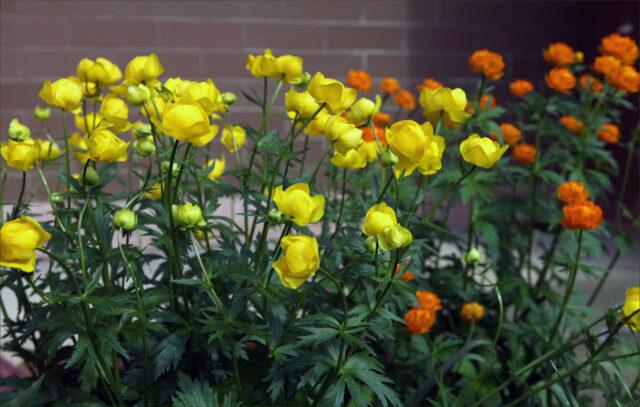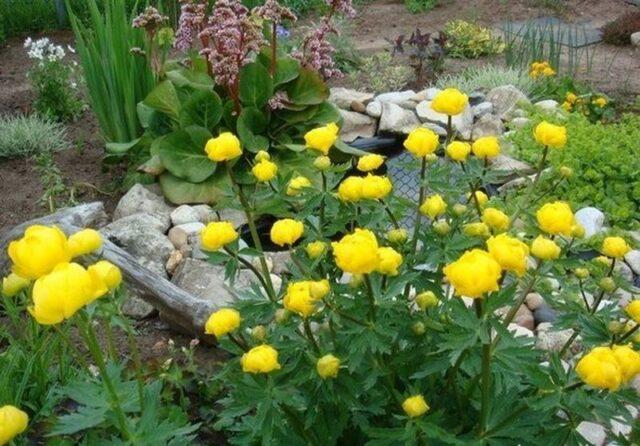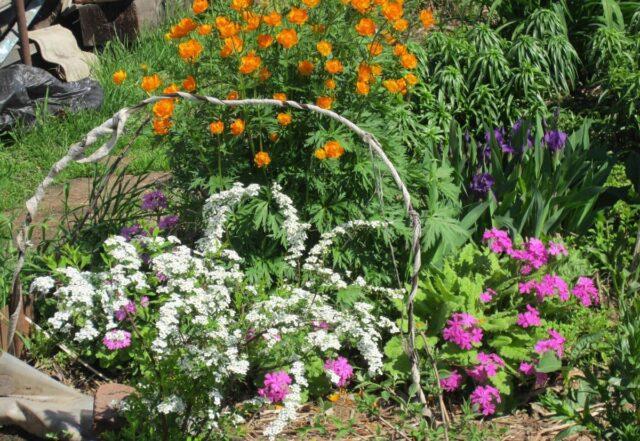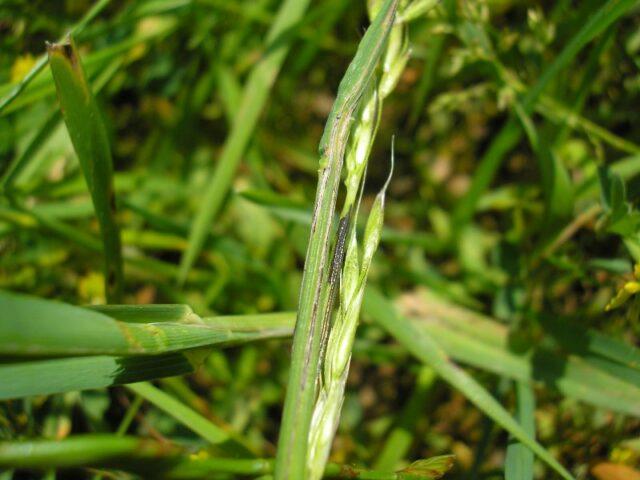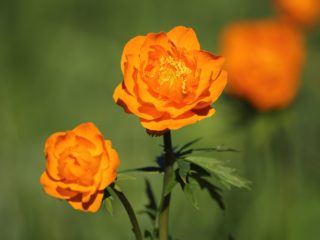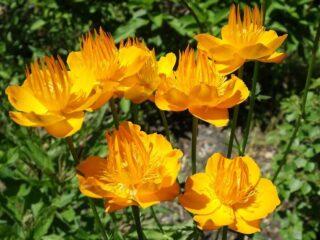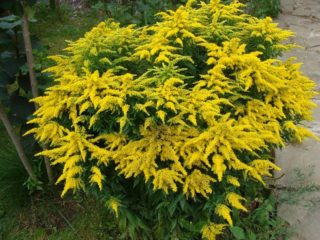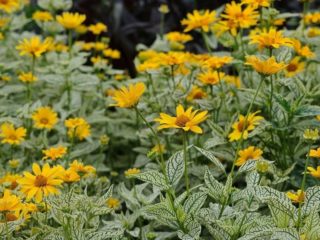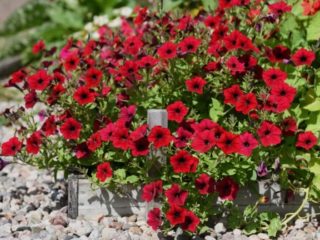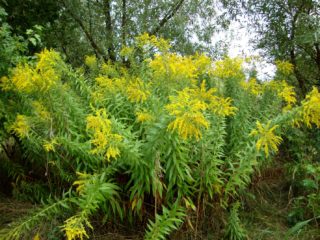Content
- 1 What does a swimsuit look like
- 2 Types and varieties of swimwear with photos and names
- 3 Swimsuit in landscape design
- 4 Breeding methods of the swimsuit
- 5 Landing the swimsuit in the ground
- 6 Swimsuit growing rules
- 7 The healing properties of the plant
- 8 Collection and procurement of raw materials
- 9 Conclusion
The description of the flower swimsuit should be studied before planting a plant in a summer cottage. Perennial is represented by many beautiful and undemanding varieties.
What does a swimsuit look like
The bather is a perennial plant from the Buttercup family. It has straight stems up to an average of 1 m in height, light or dark green leaves of a palmate-split shape.
The plant blooms from late May to August - depending on the species. Its buds are glossy, rounded, 1-2 on each of the stems, lemon yellow, golden or orange. The period of decorativeness of the plant lasts 18-25 days, the bather at this time emits a pleasant light aroma. At the end of flowering, the perennial forms rounded fruits, consisting of several leaflets with small black seeds.
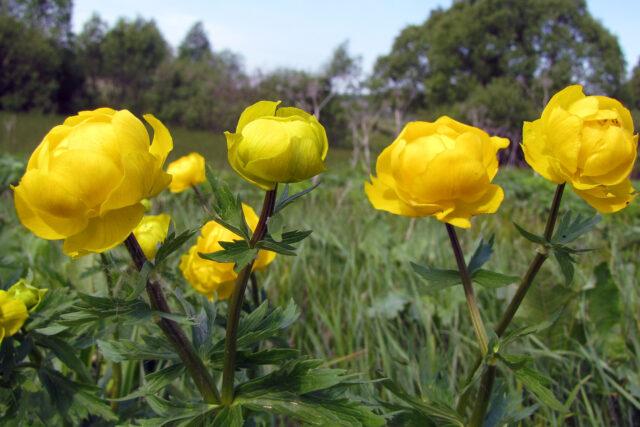
Swimsuit buds are most often closed or half-open
Where and how does the swimsuit grow
Numerous plant species are found throughout the Northern Hemisphere. You can meet the swimsuit in Western Europe and Asia, North America, in the central part of Russia and in Siberia. A perennial plant prefers to grow mainly damp meadows, river banks and forest glades, prefers moist and fertile soils.
Why is the swimsuit listed in the Red Book
Despite its widespread occurrence, the plant is classified as an endangered species. Beautiful bright flowers are massively plucked for bouquets, the number is also decreasing due to plowing of meadows and land development. In many regions, the perennial is listed in the Red Book and is protected by the state.
How to distinguish a swimsuit from a buttercup
From the photo and description of the swimsuit, you can see that it is very similar to a buttercup. The plants are closely related, bloom at about the same time and produce bright yellow buds.
But distinguishing between them is quite simple. The flowers of the swimsuit are larger, and, moreover, throughout the entire period of decorativeness, they usually retain a spherical shape, without unfolding to the end. As for the buttercup, the five petals are spread wide around the core.
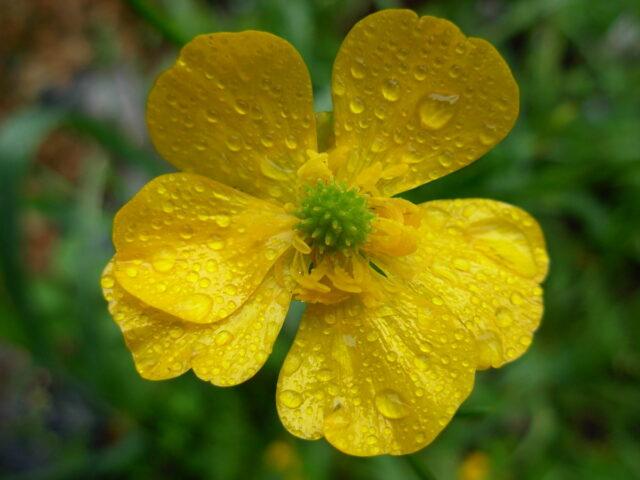
Buttercup buds are smaller than a swimsuit
Types and varieties of swimwear with photos and names
On the territory of Russia, the plant is represented by several popular species and decorative varieties. Between themselves, they differ mainly in size, shades and flowering time.
Siberian swimsuit
The Siberian swimsuit (Trollius sibiricus) rises to an average of 70 cm above the ground. It enters the decorative period in June, yields pale orange buds about 4 cm in diameter. In its natural form, the plant is found in the Far East, in the Arctic regions and in Eastern Siberia.
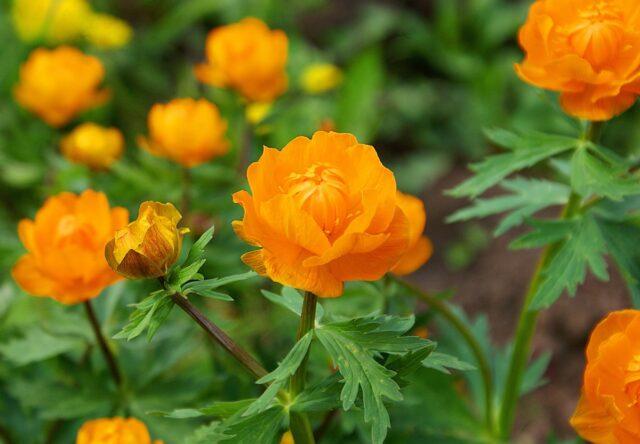
The Siberian swimsuit usually grows in swampy meadows and along the banks of water bodies
Ledebour's Bathing Suit
Ledebour's Bathing Lady (Trollius ledebourii) grows 70 cm above the ground. The leaves of the plant are dark green, widely dissected, the flowers are large, up to 8 cm wide, rounded. The buds appear closer to mid-June, they are soft orange in color. In the heart of the flower, there are upright narrow petals surrounding the underdeveloped stamens.
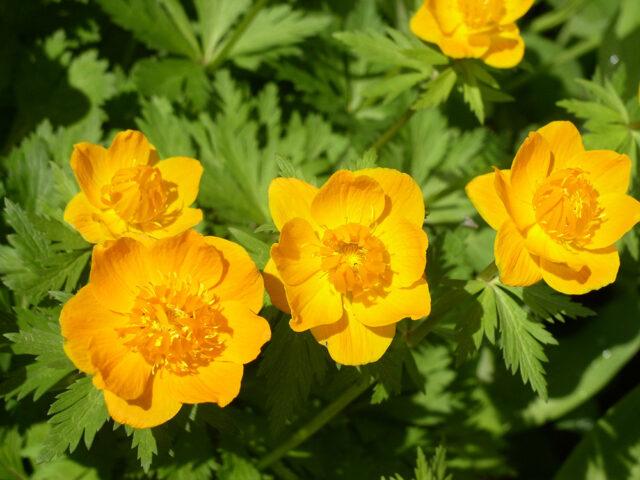
Ledebour's swimsuit can be found in its natural form in the Far East
Chinese
The Chinese swimsuit (Trollius chinensis) grows up to 1 m above the ground and has beautifully carved dark green leaves. Blooms later than other varieties - from July to August. The plant produces single open and half-closed orange-colored buds with thin long petals.
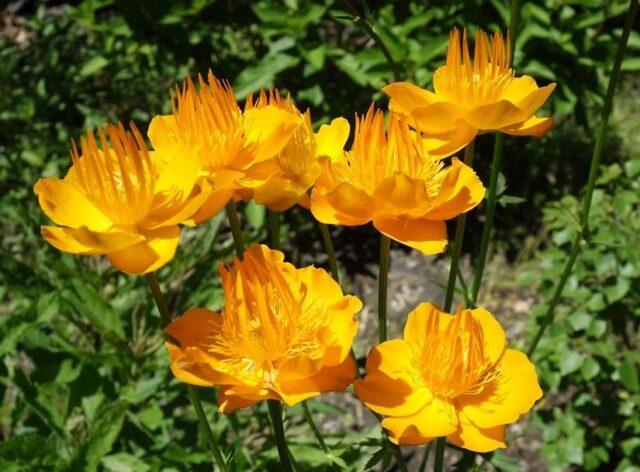
The flowers of the Chinese swimsuit reach 5 cm in diameter
Dwarf swimsuit
The dwarf swimsuit (Trollius pumilus) belongs to the undersized species and rises only 30 cm above the ground. The dense green leaves of the plant are collected in root rosettes. The buds of the variety are rounded, open, with wide petals. They are usually bright yellow, but can sometimes have a slight reddish tint.
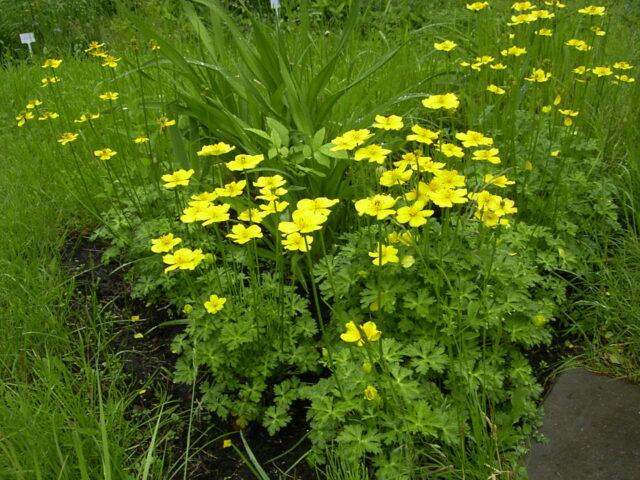
The dwarf swimsuit blooms from May to June
European
The European swimsuit (Trollius Europaeus) grows in Russia from central Russia to Western Siberia. The buds of the species are pale or golden yellow, with orange nectaries. The plant begins to bloom at the end of May.
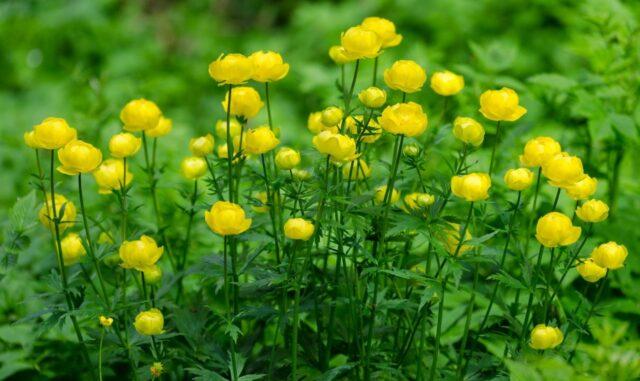
European swimsuit grows on average up to 1 m
The highest
The tallest swimsuit (Trollius altissimus) can rise up to 1.5 m, the height of the root rosette of leaves is 60 cm. The buds are yellow-green, up to 6 cm in diameter, collected in branched inflorescences. The plant of this species is of interest mainly due to its high growth, it can be used to form the background of a flower bed.
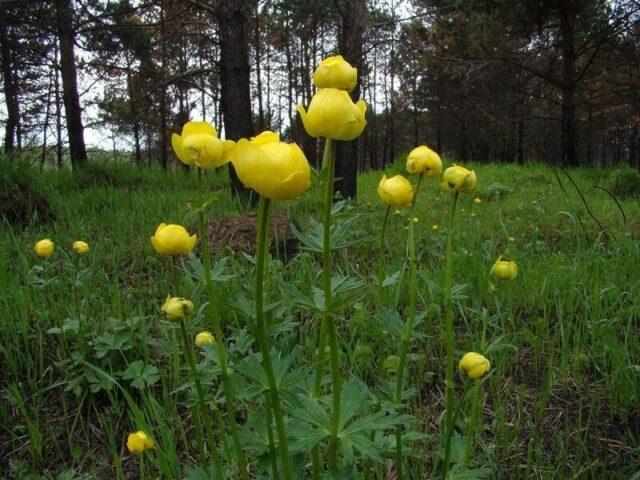
The tallest swimsuit blooms in May and June
Asian
The Asian swimsuit (Trollius Asiaticus) is found in Western and Eastern Siberia, Mongolia and Kazakhstan, grows in damp meadows, in the tundra and in the mountains. It is a perennial up to 80 cm tall, blooms from mid-May to mid-June with orange-red rounded buds.
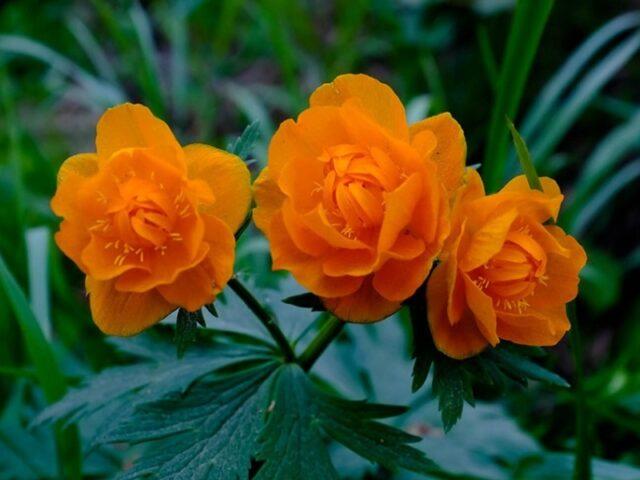
Asian swimsuit is considered a good honey plant
Lilac
The purple bather (Trollius lilacinus) grows in Altai, Mongolia, China and Central Asia. Rises about 50 cm above the ground, produces unusual lavender buds with greenish-yellow nectaries in the center. The plant blooms in late June and July.
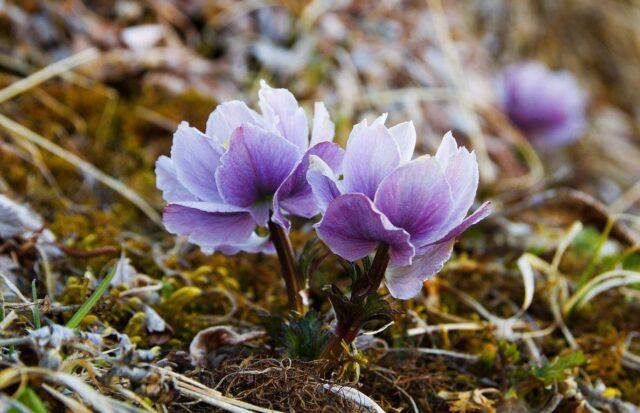
The flowers of the lilac leotard do not exceed 5 cm in width
The best varieties
Of particular interest among gardeners are decorative varieties of bathers. They are characterized by abundant flowering and rich color of large or medium-sized buds.
Lemon Queen Swimsuit
Variety Lemon Queen (Lemon Queen) - a plant up to 70 cm tall with large lemon-yellow buds. A pair of flowers may appear on each stem. The bather is compact, does not take up unnecessary space in the garden, but looks very impressive against the background of dense greenery.
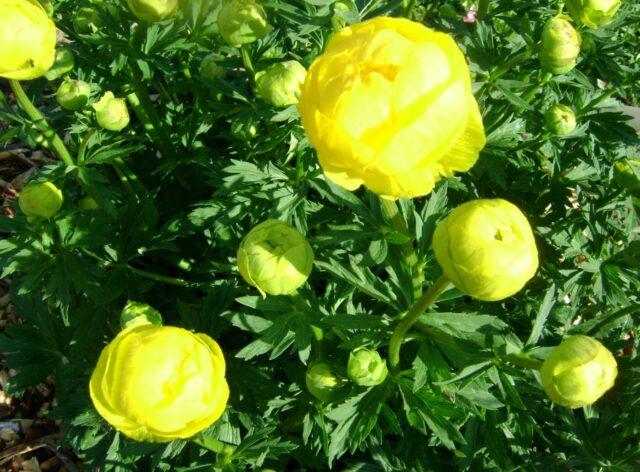
Lemon Queen variety tolerates frosts down to -40 ° С
Orange Princesses
The Orange Princess Bather produces bright orange buds about 5 cm in diameter. It blooms in May and June and requires almost no maintenance in the garden. The bather grows well on moist soils in the shade and under the sun, suitable for planting in almost any area.
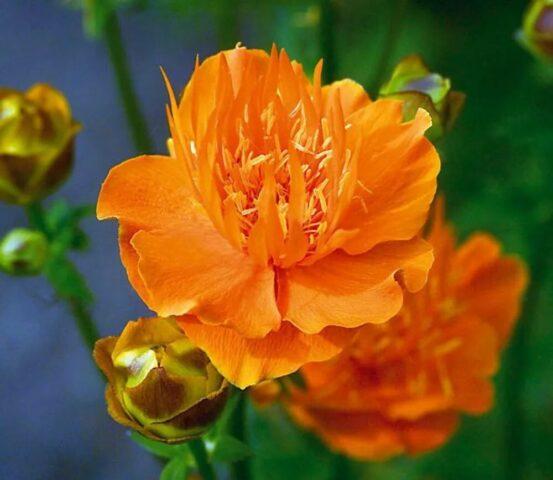
Orange Princess variety grows to an average of 50 cm
Orange Glow
The Orange Glow compact swimsuit grows up to 60 cm above the ground. In May and June, it bears numerous bright globular buds. The plant prefers well-lit places, the decorative period of the orange swimsuit lasts about a month.
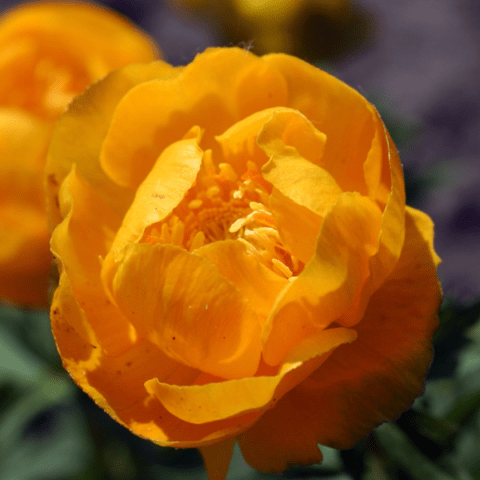
Planting Orange Glow is better on light neutral soils
Elist of All
Bather Elist of All (Earliest of All) is an early flowering plant that blooms in early May. The buds of the variety are dark yellow, with golden nectaries.The flowers do not exceed 4 cm in diameter, but at the same time they cover the perennial very abundantly and look spectacular and bright.

Elist of All grows no more than 50 cm
Etna
The Etna Baths are in full bloom in May and June. The buds of the variety are yellow-orange, bright and showy. Also noteworthy are the beautiful glossy leaves of the plant, green with a slight silvery tint.
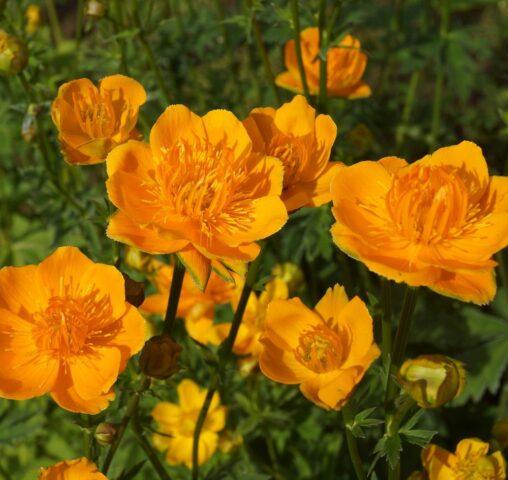
Etna variety rises 60 cm above the ground surface
Goliath
The Goliath Bath (Goliaf) is a tall plant up to 90 cm. It attracts attention due to the large dark orange buds with a lighter core. Each flower can reach 7 cm in diameter.
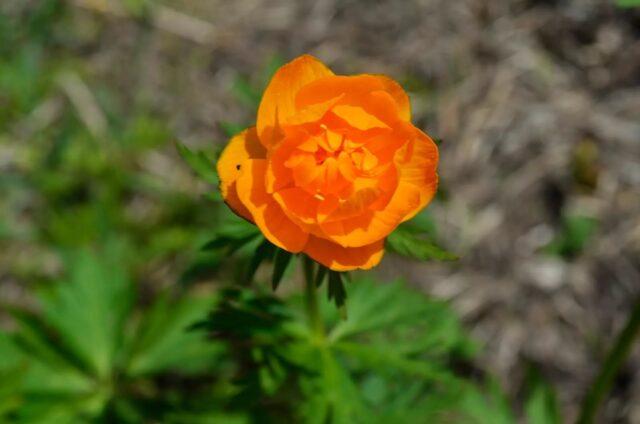
The Goliath variety blooms in the second half of May.
Alabaster
An unusual variety of the Alabaster swimsuit is distinguished by large buds up to 6 cm in the original light cream shade. The flowers are semi-double, very beautiful, with pinkish petals at the tips. The plant blooms in May-June and again in August and September.
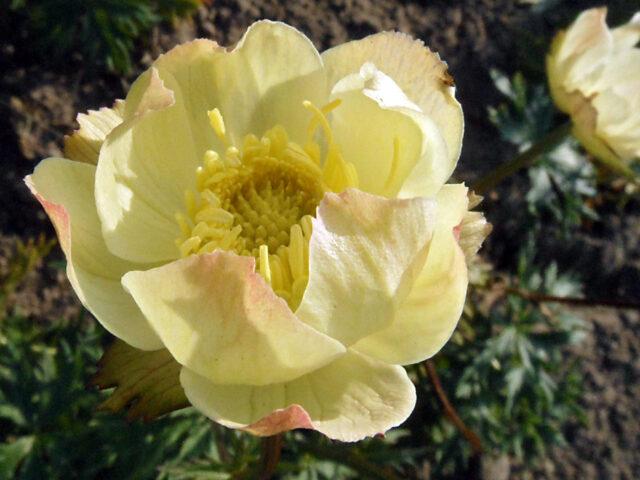
The height of the Alabaster variety is about 35 cm
Cheddar
The beautiful Cheddar bather has delicate creamy yellow buds with lemon stamens and looks very graceful in the garden. The plant usually rises 70 cm above the ground, and emits a pleasant aroma during the decorative period.
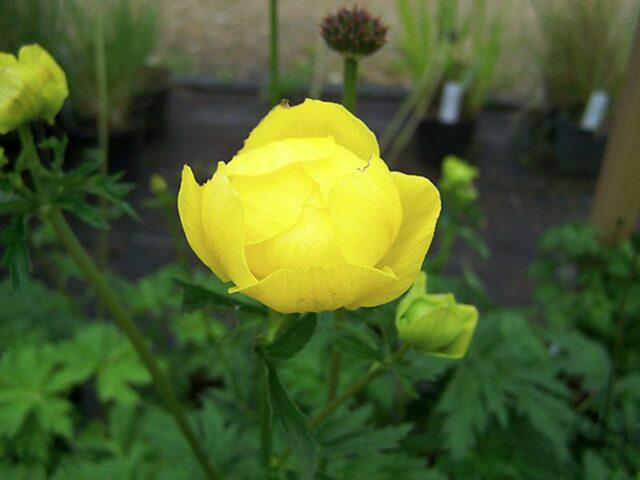
Flowering of the Cheddar variety occurs in May and again in August.
Swimsuit in landscape design
A compact but bright swimsuit that can decorate any area. It is actively used in landscape design in single and group compositions. The plant is well suited:
- to decorate the front areas of the garden;
The bikini looks bright in front of the house and along the paths
- for the decoration of rocky areas;
Low-growing varieties of a swimsuit look organically among the stones
- for planting on flower beds;
The bather, depending on the variety, can form the foreground or background of the composition.
- for decorating the shores of reservoirs;
Swimsuit feels comfortable in wet areas
The plant can coexist with delphinium, irises, edelweiss, marigolds, spirea and other perennials.
Breeding methods of the swimsuit
There are several ways to propagate a plant on a site.
- Seeds... Planting material is subjected to preliminary stratification at home for 3-4 months at temperatures up to 4 ° C. In the spring, the seeds are transferred to light loose soil, after the appearance of the second true leaf they dive. It is advisable to grow a perennial in a seedling box for a couple of seasons; it is transferred to a permanent place in the second or third year.
- By dividing the bush... A healthy adult plant bush in August or early September is dug out of the ground and divided into several parts, with at least two shoots on each and strong roots. The seedlings are immediately transferred to a new place, without shaking off the soil, and then watered and shaded until the perennial takes root properly.
- Cuttings... In spring and summer, young lower shoots or basal rosettes with a part of the underground core are separated from the adult plant. The stalk is transferred directly into the ground and provides it with high-quality moisture and protection from direct sun.
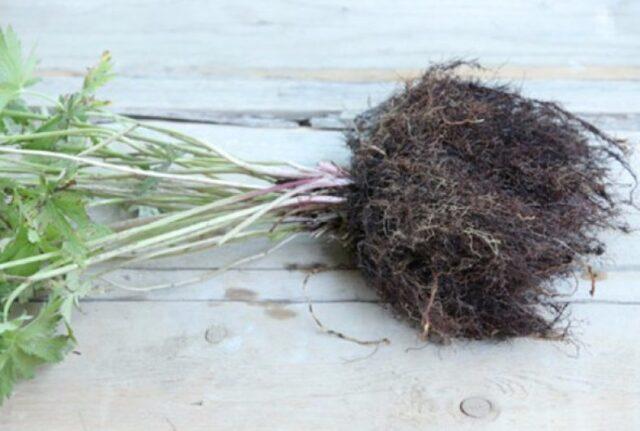
When dividing a bush, the roots of the plant do not need to be peeled so as not to damage them
Landing the swimsuit in the ground
Planting and caring for a swimsuit in the open field is not particularly difficult. However, in the process, you need to adhere to several important rules.
Recommended timing
Unlike many plants, it is recommended to plant a swimsuit not in spring or autumn, but at the end of summer, in August. In this case, the perennial is guaranteed to have time to take root in the heated soil and will not suffer from the winter cold.
Site selection and soil preparation
Most species and varieties of plants tolerate partial shade well, but prefer open, sunny places. It is best to plant the crop in areas with diffused lighting, such as near trees or tall shrubs.
The flower prefers soil light, neutral or slightly acidic, with a high humus content. The perennial takes root well on loams, loves moisture, but at the same time does not react well to stagnant water.
Landing algorithm
Shortly before planting seedlings or seedlings, the selected area must be dug up and, if necessary, diluted with sand or fertilized with peat and humus. For a decorative perennial, a small hole is prepared, twice the size of the roots. When placing several plants at once, 50 cm of space is left between the pits.
Before planting, rubble or broken brick is poured onto the bottom of the hole for drainage, and then the hole is half-filled with a mixture of garden soil, sand and peat. The seedling is carefully lowered onto the formed mound, deepening the root collar by 2 cm, covered with the remains of the soil and watered. With proper planting, the perennial should take root quickly - on average in a couple of weeks.
Swimsuit growing rules
A perennial plant has low maintenance requirements. It is easy to grow it in the country, if you do not forget about the main points.
Watering and feeding
Perennials in the garden need constantly moistened soil. During active growth and flowering, as well as during dry periods, the plant is watered with lukewarm water once a week or more often, as the soil dries out. If the perennial is located near a pond or stream, you can do without additional moisture.
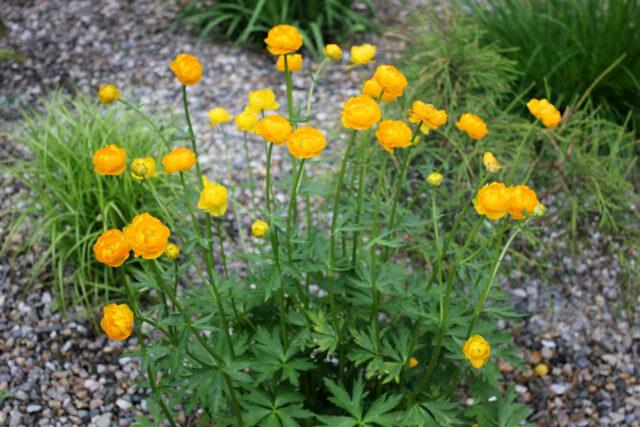
To protect against weeds, the soil at the roots of the bathing suit can be mulched or covered with rubble
It is necessary to feed the culture twice a season - in early May and before flowering. Complex minerals containing nitrogen, potassium and phosphorus are used, the dosages are measured very small - 5-10 g of fertilizer per bucket of water.
When and how to transplant a swimsuit
It is advised to transplant a swimsuit less often, the plant does not like frequent changes of location. It is advisable to carry out the procedure no more than once every five years.
Work begins in the middle of summer at the end of flowering, when the perennial goes into a state of dormancy. The bush is carefully dug in and with a sharp knife or shovel it is divided into parts with 3-4 growth buds on each, after which it is immediately transferred to a new site. At first, the seedling is shaded from direct sunlight.
Preparing for winter
Most varieties of perennial plants are characterized by good cold resistance and can withstand frosts down to -30 ° C without shelter. Shortly before the onset of winter, it is recommended only to cut off the aerial part of the culture, leaving the cuttings no more than 3 cm in height. If desired, a perennial can be thrown from above with fallen leaves, straw or spruce branches, this will protect the roots from freezing.
Diseases and pests
The bather is a hardy and viable plant with good immunity. However, sometimes perennials can affect fungal diseases. The greatest danger is posed by:
- septoria - the disease leaves brown or orange spots with a yellowish border and black dots on the leaf plates;
If untreated, septoria leads to deformation and drying out of the plant.
- smut - with this disease, the perennial slows down its development, and whitish and dark growths appear on the stem and leaves;
The smut weakens the swimsuit and reduces its frost resistance
With symptoms of fungal diseases, the plant must be treated with Bordeaux liquid or copper sulfate. At the same time, the affected parts of the perennial are cut off and burned.
Of the parasites, nematodes are the most dangerous for the swimsuit. Worms harm the roots, form characteristic growths on them, over time, the perennial begins to darken and die off the leaf plates.In the early stages, the infection can be eliminated with the drugs Phosphamide and Heterophos.

In advanced stages, nematodes do not respond to treatment and the plant should be destroyed.
The healing properties of the plant
Leaves and flowers are used in traditional medicine. When used carefully, the plant:
- helps with skin irritation and damage;
- has a diuretic effect;
- regulates the menstrual cycle in women;
- serves as the prevention of scurvy and vitamin deficiency;
- improves the condition in diseases of the gallbladder;
- helps with ailments of the stomach and intestines.
In this case, the root of the bathing suit contains toxic substances in its composition. For the treatment of ailments, it is rarely used and mainly by external methods.
Application in traditional medicine
The leaves and flowers of the plant contain a large amount of valuable substances. Among the main ones you can list:
- flavonoids;
- coumarins and saponins;
- ascorbic acid;
- fixed oils;
- choline;
- lipase;
- phenolcarboxylic acids.
Due to the rich chemical composition, traditional medicine uses the plant to treat the following diseases:
- epilepsy;
- scabies;
- furunculosis;
- diarrhea;
- edema and dropsy;
- ailments of the kidneys and liver.
The bather has anti-tumor properties. In combination with official drugs, the plant is used in cancer therapy.
Limitations and contraindications
In general, the swimsuit is considered a fairly safe plant. But since its effect on the human body has not been thoroughly studied from a scientific point of view, in some cases it is better to refuse to use the herb. It is forbidden to use funds based on it:
- during pregnancy and breastfeeding;
- if you have an individual allergy;
- with exacerbations of pancreatitis and stomach ulcers.
During treatment with a bathing suit, the dosages indicated in the prescriptions must be carefully observed. For the first time, plant-based products are tried with great care and in minimal quantities to check if there is a negative reaction of the body.
Collection and procurement of raw materials
It is necessary to collect the swimsuit for medicinal purposes from June to July, during the flowering period of most plant species. The place for the procurement of raw materials is chosen clean, located away from roads, large cities and industrial facilities.
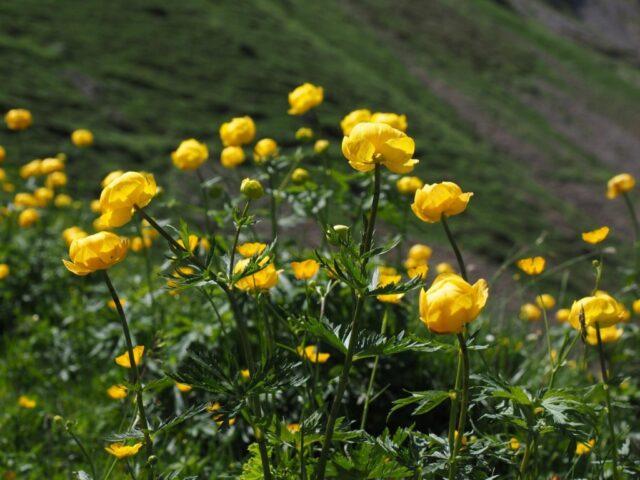
You need to prepare a swimsuit on a dry and clear day.
For medical use, it is customary to collect stems, buds and leaves. Immediately after preparation, they are laid out on a baking sheet or on a sheet of cardboard and left in the fresh air under a canopy until completely dry. Direct sunlight should not fall on the plant, since ultraviolet light destroys useful substances in the composition of raw materials.
High-quality dried grass is poured into paper bags or glass jars and stored in a dark place with low humidity. The plant retains its beneficial properties for up to three years. During this period, the workpieces need to be agitated from time to time so that mold does not start in them, and check for insects.
Conclusion
Flower description bather is a beautiful and useful plant with low maintenance requirements. The perennial not only decorates the garden, but also helps in the treatment of ailments while following the proven recipes of traditional medicine.
